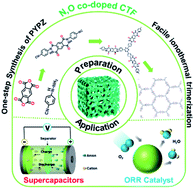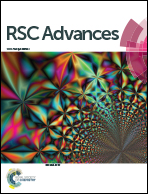Bottom-up fabrication of triazine-based frameworks as metal-free materials for supercapacitors and oxygen reduction reaction†
Abstract
Doping porous carbon materials with heteroatoms is an effective approach to enhance the performance in the areas of supercapacitors and the oxygen reduction reaction (ORR). However, most traditional heteroatom-doped metal-free porous carbon materials have random structures and pore distributions with high uncertainty, which is harmful for a deep understanding of supercapacitors and the ORR mechanism. Basing on the molecular design, a series of N, O co-doped porous carbon frameworks (p-PYPZs) has been prepared through the template-free trimerization of cyano groups from our designed and synthesized 2,8-bis(4-isocyanophenyl)-2,3,7,8-tetrahydropyridazino[4,5-g]phthalazine-1,4,6,9-tetraone (PYPZ) monomer and subsequent ionothermal synthesis, which has the advantage that the type, position, content of the heteroatom and the pore structure in the porous carbon material can be regulated. Nitrogen and oxygen atoms introduced via covalent bond and the hierarchically porous structure endow the material with excellent cycling stability, and 110% capacitance retention after 35 000 cycles in 1 M H2SO4. A symmetric supercapacitor was assembled with the material and shows an energy density of 32 W h kg−1. The material can be applied to the area of oxygen reduction reaction as a metal-free catalyst with an onset potential of 0.85 V versus RHE, indicating the good catalytic ability. The material exhibits excellent methanol crossover resistance and a four-electron pathway mechanism. Results also indicate a positive correlation between the N-Q content and the selectivity of the four-electron pathway. In this paper, the electrochemical properties of materials are regulated at the molecular level, which provides a new idea for further understanding the electrochemical mechanism of energy storage devices.



 Please wait while we load your content...
Please wait while we load your content...